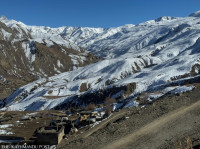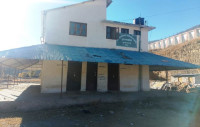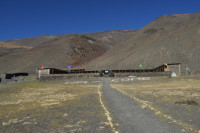Karnali Province
Tuin becomes a thing of the past in Kalikot district
A total of 19 motorable bridges have been constructed in the outlying district so far replacing the makeshift cable crossings, locally known as tuin.
Tularam Pandey
Until five years ago, Dhir Bahadur Shahi, a 52-year-old man from Rengil in Khandachakra Municipality Ward 11, had to use a tuin, an improvised cable crossing, to cross the Karnali river on his way to the market areas along the Karnali corridor. Back then, locals like Shahi had no option but to rely on the precarious tuin to cross the river. Students from various villages of Khandachakra-11 would use the tuin daily to go to schools in the neighbouring villages. “Students from Jaikot would cross the river on the tuin to attend Karnali Secondary School in Rengil,” Shahi recalls. “If the tuin was inoperable, they would have to take a two-hour detour to reach school.”
No more. A suspension bridge constructed some five years ago over the Karnali river has averted the ordeal for the villagers of Khandachakra-11. “The bridge has come as a boon for us all,” Shahi says.
The construction of suspension bridges over the Karnali river in various places gained momentum in the past five years making the lives of the Kalikot locals easier.
The District Coordination Committee recently declared that Kalikot was now a tuin-free district.
According to Basanta Bishwakarma, a 45-year-old resident of Khulalu, between 2000 and 2003, around a dozen people died and one person went missing in the rivers while using the tuins at Kalapahara, Lalighat and Bhattadi of Khandachakra Municipality and Tilagufa Municipality.
A total of six suspension bridges were built over the Karnali and Tila rivers during the Panchayat era, but the bridges were badly damaged during the Maoist insurgency, according to Damanraj Bam.
“After the bridges were damaged, we had no alternatives to using tuins to cross the rivers,” says Bam. “If we didn’t use tuins, it would take us two to three days to reach the district headquarters in Manma from Khandachakra Municipality.”

The construction of suspension bridges took off after the Karnali Corridor came into operation, says Sattal Singh Budha, a local man from Raku village. “It was a huge relief for us.”
Students who attend schools outside their native village have benefited the most from the construction of suspension bridges.
Ramesh Malla, who studies at the Panchadev Secondary School in Manma, says it used to take him several hours to reach his school, but now after the operation of the suspension bridge at Serighat Jhamla, it takes him no more than 15 minutes. “Our journey to school is no longer risky,” Malla says.
A total of 32 bridges were built in Kalikot after the armed conflict era with the coordination of the Ministry of Federal Development.
According to Kammar Bahadur Bam, a junior engineer currently working at the District Coordination Committee, the last of the tuins was replaced by a suspension bridge at Tilagufa Municipality Ward 5, connecting Dhanada to Bhattadi, in the fiscal year 2020-21.
There was only one suspension bridge at Rengil over the Karnali river in Kalikot district before the restoration of democracy in 1990. People had to cross the river using tuins, some of which were made locally using Babiyo (Eulaliopsis binata) rope. Around 15 to 20 people would die every year while crossing the rivers through tuins in the district, according to Dip Bahadur Shahi, chairman of the then District Development Committee and District Panchayat. According to him, the construction of the bridge at Rengil started in 1975 and was completed after two years.
The Rengil bridge was the trade route for the people of Kalikot, Bajura, Humla, Mugu and Jumla to reach Katase of Kailali district and Rajapur of Bardiya district. The sheep, cattle, goats, horses and mules of the Karnali region used to cross the river through the bridge. There are now several bridges over the Tila and Karnali rivers at Khulalu, Bhattadi, Lalighat, Lapha, Pantadi, Pili, and Bhigm, among other places.
Likewise, suspension bridges have been constructed across the Rahagad, Sannigad, Bhartagad, Baligad, and Jhyagad, among other streams in the district.
So far, a total of 19 motorable bridges have been constructed in Kalikot. There are bridges at Daikhola, Kalekhola, Serighat, Mathillo Serighat, Simlagad, Chaukhola, Takulla, Bali, Tallo and Mathillo Khallagad and Chhidena along the Karnali Highway. Similarly, seven motorable bridges have been constructed at different places along the Karnali corridor. However, the bridges which were destroyed by the floods last year in Haudi, Rahagad and Bhaisegauda are yet to be repaired.




 16.12°C Kathmandu
16.12°C Kathmandu










